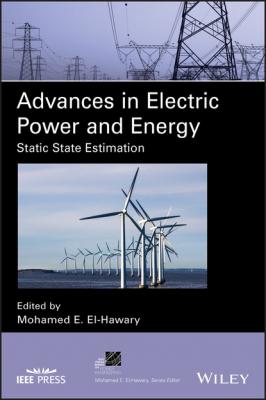Advances in Electric Power and Energy. Группа авторов
Читать онлайн.| Название | Advances in Electric Power and Energy |
|---|---|
| Автор произведения | Группа авторов |
| Жанр | Физика |
| Серия | |
| Издательство | Физика |
| Год выпуска | 0 |
| isbn | 9781119480440 |
2.5.6.2 LTS Mathematical Programming Formulation
The mathematical programming formulation of the LTS method is
(2.42a)
subject to
(2.42b)
(2.42c)
(2.42d)
(2.42e)
(2.42f)
Again, parameter ν identifies the median and can be computed as [26]
(2.43)
Problem (2.42) minimizes the sum of all squared variables si. Note that the number of optimization variables for the proposed LTS formulation is larger than that of any of the previous formulations.
2.5.7 Least Measurements Rejected
References [28, 29] propose a mathematical programming formulation for the least measurements rejected (LMR) estimator. The underlying idea is to find the largest set of measurements whose errors are within a given tolerance T, i.e. to minimize the number of measurement errors that are out of tolerance. Hereafter, this estimator is denominated as LMR.
2.5.7.1 LMR General Formulation
The general formulation of the LMR estimator is
(2.44a)
subject to
(2.44b)
(2.44c)
where card(Ω) represents the cardinality of set Ω and ΩBM is the set of those measurement errors that are out of tolerance, i.e. with ∣yi(x) ∣ ≥ T.
2.5.7.2 LMR Mathematical Programming Formulation
The mathematical programming formulation for the LMR estimator proposed in [28, 29] is
subject to
(2.45c)
(2.45d)
(2.45e)
In (2.45b), note that each binary variable bi indicates whether or not the ith weighted measurement error (yi(x)) is within the range [−T, T ]. Specifically, the value bi = 0 implies that ∣yi(x ) ∣ ≤ T. On the other hand, the value bi = 1 implies that ∣yi(x) ∣ > T. Since the objective function (2.45a) minimizes the sum of all binary variables bi, the LMR procedure searches the largest set of measurement errors within the range [−T, T].
Once problem (2.45) has been solved and the set of out‐of‐tolerance measurement errors has been identified, a WLS estimation is performed to enhance the estimation quality, considering only those measurements whose associated binary variables have optimal values that are equal to zero [28].
2.5.8 Formulation Overview
Table 2.7 provides a general overview of the computational requirements needed to formulate the considered estimators as mathematical programming problems. This table contains the following information:
The first column indicates the estimation techniques considered.
The second and third columns indicate whether or not a large parameter M and/or a predefined tolerance T is required.
The fourth and fifth columns show the number of continuous/binary optimization variables.
The sixth column indicates the number of additional constraints required.
Finally, the seventh column denotes the nature of the resulting mathematical programming problem.
TABLE 2.7 Characterization of different state‐estimation formulations.
| Parameter M | Tolerance T | Continuous variables | Binary variables | Additional constraints | Problem type | |
|---|---|---|---|---|---|---|
| WLS | ✗ | ✗ | n | — | 0 | NLP |
| LAV | ✗ | ✗ | n + m | — | 2m | NLP |
| QC | ✗ | ✓ | n | m | 0 | MINLP |
| QL | ✗ | ✓ | n + m | m | 2m | MINLP |
